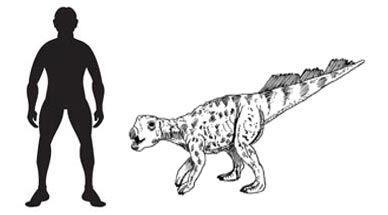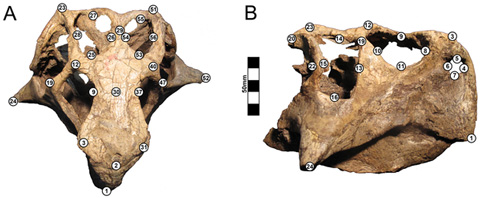Psittacosaurus Proves that Three Goes into One
New Study of Psittacosaur Skulls Shows Three Species are Actually Just One Species
In a new study of Psittacosaurus fossils from China carried out by University of Pennsylvania researchers, the number of known species of this dinosaur has been reduced from fifteen to thirteen. It seems that what was once thought to be three different types of “parrot lizard” living in China actually may be just one species. Differences in the morphology of the fossil material had led to the establishment of three separate species but these differences relate to compression and distortion that occurred as the fossil material was buried and preserved, they do not relate to anatomical differences that would be expected if these animals were indeed different species.
Psittacosaurus
Psittacosaurus is one of the most abundant and speciose genera of all the known Dinosauria. There had been fifteen named species, with fossil finds in Russia, Mongolia and Thailand as well as in China. The research team, writing in the scientific jounal PLoS One (Public Library of Science), state that what was once thought of being three separate species from the Psittacosauridae family excavated from strata in the Yixian Formation of north-eastern China – P. lujiatunensis, P. major, and Hongshanosaurus houi are actually the same dinosaur. All the psittacosaur material represents P. lujiatunensis.
Known to science for ninety years or so, psittacosaurs were relatively small, slender, bipedal members of the ornithischian group of dinosaurs. Fossils date from around 130 million years ago to approximately 100 million years ago. Most probably herbivorous, these dinosaurs, most of which were less than two metres in length, are distantly related to the giant Late Cretaceous horned dinosaurs such as Triceratops, Styracosaurus and Chasmosaurus.
An Illustration of Psittacosaurus
Picture credit: Everything Dinosaur
Three-dimensional Geometric Morphometrics
Commenting on their findings Peter Dodson, (Professor of Anatomy at the University’s School of Veterinary Medicine) stated:
“Because of the vagaries of fossilisation, no two fossils are the same. Animals are alive and they die, but what’s crucial in palaeontology is what happens to the animals after they die.”
The research team used a process called three-dimensional geometric morphometrics to compensate for the crushed and distorted fossil material, thus revealing the affinities between different fossil specimens. This is the first time this laser-based examination technique has been used on dinosaur fossils and this study could have implications for other genera.
New Study Re-assigns Fossil Material
Picture credit: PLoS One
Many New Genera Named
Over the last thirty years or so a large number of horned dinosaur fossils have been found in North America. As a result, many new genera and species have been erected. Three-dimensional geometric morphometrics if applied to North American ceratopsian specimens may help to confirm speciation or indeed lead to a re-assignment of some fossil material.
A spokesperson from Everything Dinosaur commented:
“This technique permits scientists to assess the variation in skull morphology. Given enough specimens to study and this work could have implications for other dinosaur genera, extinct animals which have left us fossils which were thought to represent a new species unknown to science may turn out to be examples of already known and described species.”
The Beasts of the Mesozoic range contains several different, articulated horned dinosaur figures including Psittacosaurus (whilst stocks last).
To view the Beasts of the Mesozoic range: Beasts of the Mesozoic Articulated Dinosaur Figures.



